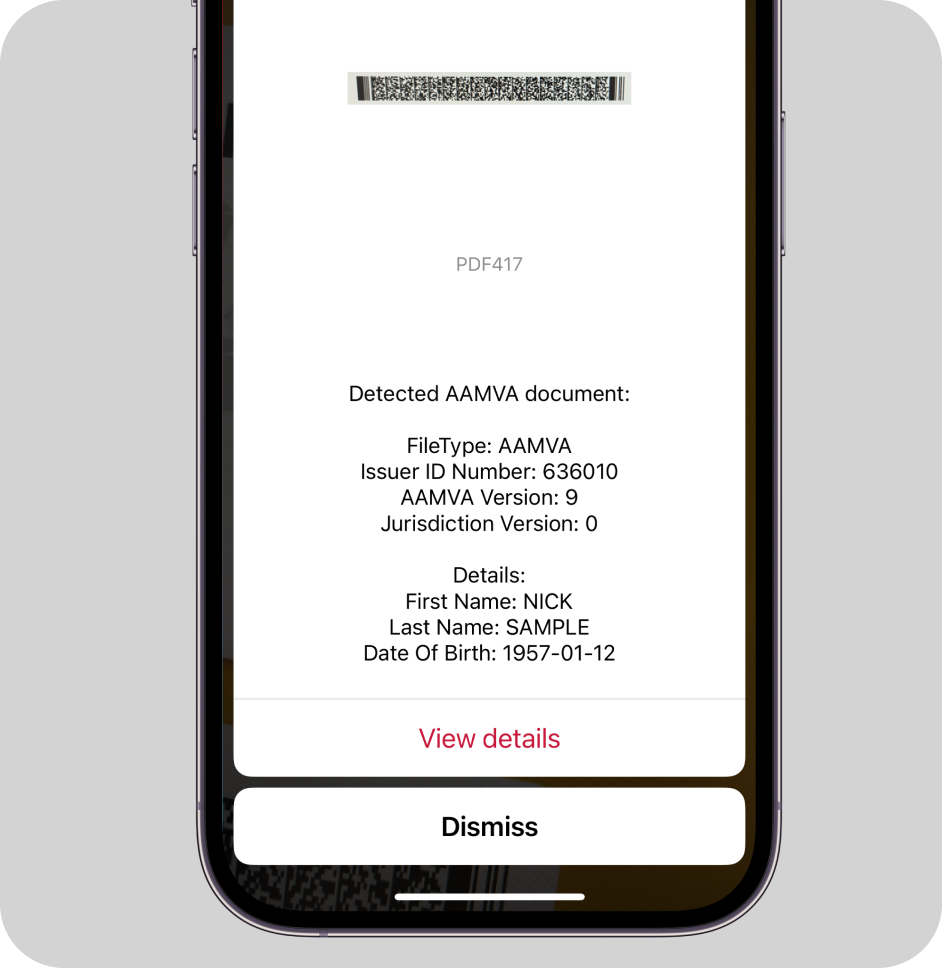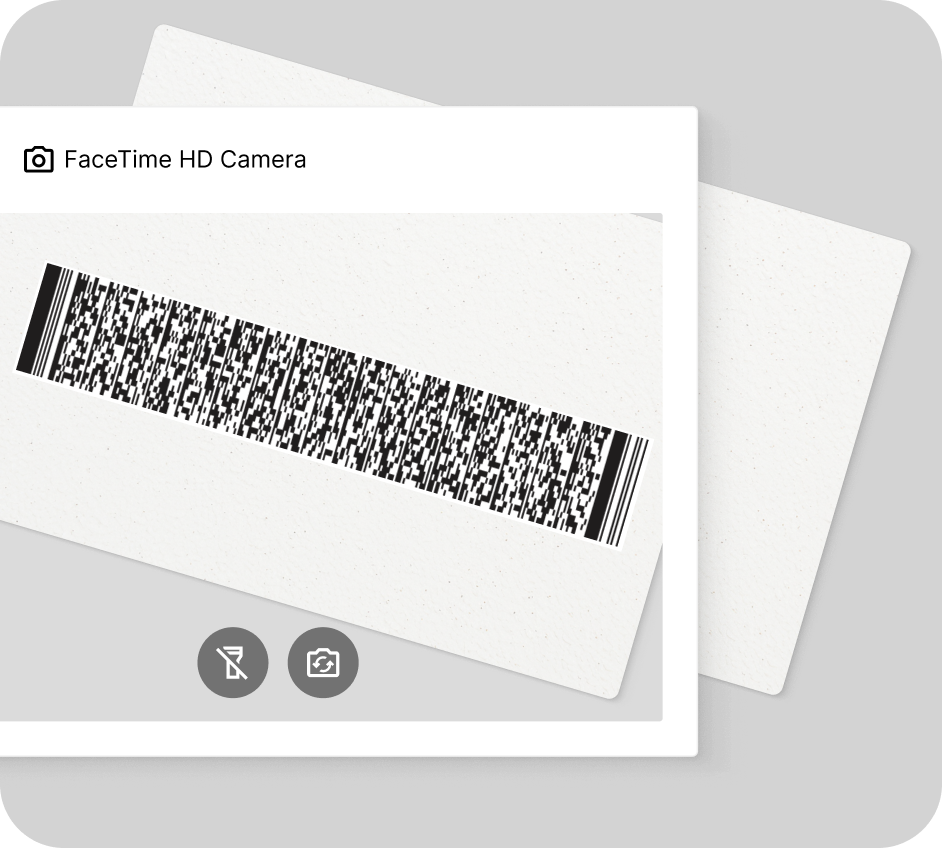AAMVA Barcode Scanner
Extract barcode data from PDF417 on AAMVA documents
Trusted by
300+
global
industry leaders
Turn smartphones into fast & reliable scanners for AAMVA documents
The Scanbot Barcode Scanner SDK ensures outstanding performance, such as scanning faded or creased driver’s licenses carried in wallets. With a scanning speed of under 0.04 seconds, your users get instant reads for seamless workflows. To decode the raw PDF417 data into a human-readable format, use our U.S. Driver’s License Scanner SDK, which includes an AAMVA parser.
Key benefits include:
- Offline scanning: The Scanbot SDK works 100% on-device, ensuring both uninterrupted performance and data security.
- Enterprise-grade support: Get dedicated chat support via Slack, Teams or email for any issue. Includes free assistance during the integration phase.
- Flat pricing model: Cost stays the same no matter how much your user base or scanning volume grows.


How this scanning tool works
Our free online barcode scanning software reads PDF417 codes directly through your camera or on imported images. This barcode scanner works in any browser, no app download or signup needed.
NOTE: This tool only reads the barcode. Use the Scanbot Data Capture SDK web demo to parse and access the information in a human-readable format, directly from your camera.
(We don’t store any images or data you import. Everything stays on your device.)
Understanding PDF417 codes
What are PDF417 codes?
PDF417 codes are two-dimensional barcodes designed to encode large amounts of data in a compact, flexible format. The name “PDF” stands for “Portable Data File,” emphasizing the code’s ability to carry complex data sets. These barcodes consist of multiple rows and columns of linear codes that can store up to 2,725 numeric characters or 1,850 alphanumeric characters.

Defined in the ISO/IEC 15438 standard, PDF417 codes are highly scalable, making them suitable for a variety of applications that require different formats. They have built-in error correction, ensuring accurate decoding even when parts of the barcode are damaged or obscured.
In the U.S. and Canada, PDF417 is commonly used on driver’s licenses and other identitiy cards to store essential personal information. The American Association of Motor Vehicle Administrators (AAMVA) has created additional guidelines for encoding data specifically on U.S. and Canadian driver’s licenses, adapting the ISO/IEC 15438 standard to meet local regulatory and operational needs.
Applications of PDF417 codes on AAMVA documents
Driver’s licenses
Most U.S. and Canadian driver’s licenses include a PDF417 that follows the AAMVA standard. This barcode encodes essential information such as the driver’s name, date of birth, address, license number, expiration date, and restrictions. Law enforcement officers, retailers, and other organizations use barcode scanners to quickly extract and verify this data for identity checks, age verification, and fraud prevention.
ID documents
Many government-issued identification cards in the U.S. and Canada, such as state ID cards and national ID cards use PDF417 codes.
Structure of PDF417 codes on AAMVA documents
The PDF417 barcode on the back of a driver’s license has a start pattern (left) and an end pattern (right). In the middle section, the mandatory data elements on AAMVA documents are encoded.

The three letters in front are the data item’s corresponding element ID:
-
- DCA: Vehicle class(es) the cardholder is allowed to drive
- DCB: Restrictions on driving privileges (e.g., only automatic transmission)
- DCD: Additional privileges granted to the cardholder (e.g., transportation of hazardous material)
- DBA: Expiration date of the document
- DCS: Last name / family name
- DAC: First name
- DAD: Middle name(s)
- DBD: Issue date of the document
- DBB: Date of birth
- DBC: Gender
- DAY: Eye color
- DAU: Height
- DAG: Address: Street name
- DAI: Address: City name
- DAJ: Address: State name
- DAK: Address: Postal code
- DAQ: ID number of the cardholder
- DCF: ID number of the document
- DCG: Country in which the document was issued
- DDE: Indicator that the last name is truncated
- DDF: Indicator that the first name is truncated
- DDG: Indicator that the middle name(s) are truncated
Advantages of PDF417 codes
- High data capacity: Store up to 2,725 numeric or 1,850 alphanumeric characters, ideal for complex datasets.
- Adjustable size: Customizable length and width make them suitable for various surfaces and applications.
- Error correction levels: Robust built-in error correction ensures data readability even when parts of the barcode are damaged.
- Versatility: Suitable for a wide range of industries and applications, from ID verification to postal parcels and logistics.
Why choose the Scanbot SDK for PDF417 scanning?
The Scanbot Barcode Scanner SDK is specifically designed to handle the challenges of decoding PDF417 codes in real-world scenarios.
What sets us apart:
- Exceptional performance: Reliably decodes even damaged, low-contrast or distorted barcodes.
- High-speed scanning: Read PDF417 codes in as little as 0.04 seconds for quick identification.
- Cross-platform compatibility: Easily integrate with Android, iOS, cross-platform, web, Windows, and Linux platforms.
- Customizable UI: Customize the ready-to-use components to match your app or website design.
- Privacy-first: Operates offline for complete data security.
Whether your use case involves PDF417 codes, UPCs, QR codes, or any other barcode, the Scanbot SDK delivers the accuracy, speed, and reliability you need to succeed.
Related Barcode Types:
Frequently Asked Questions
Where is PDF417 used?
PDF417 barcodes are widely used on U.S. and Canadian driver’s licenses and government-issued ID cards, following the AAMVA standard to encode key details for identity verification, age checks, and fraud prevention. They are also commonly used in ticketing, healthcare, and logistics for identification and tracking purposes.
How does parsing from AAMVA documents work?
A barcode reader linked to a data parser can decode the information encoded by a PDF417 barcode to be easily readable by humans. The scanner captures the barcode's data, and the data parser processes it to extract specific information, such as date of birth or street name.
How can Scanbot SDK help you with parsing from AAMVA documents?
The Scanbot Barcode Scanner SDK delivers exceptional performance in challenging environments, including damaged or curved barcodes, with a scanning speed of under 0.04 seconds for seamless workflows. Try it now with a free trial license.